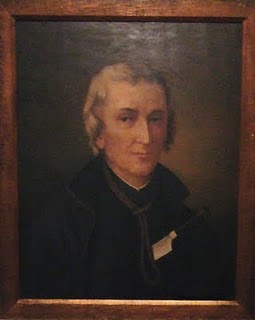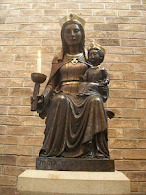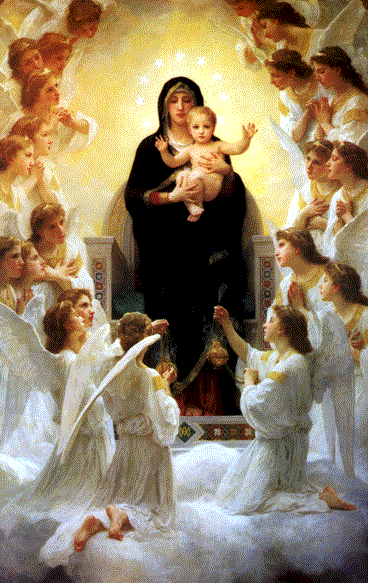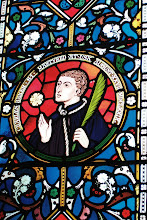During the long reign of Queen Elizabeth I, it was the Government’s intention that the Catholic faith in the British Isles would die with the Marian priests. No priests, their reas oning ran, no Catholicism! However, many Catholics clung tenaciously to their faith but, as the priests ordained in Mary’s reign died, there were none to replace them. Cardinal William Allen conceived of a plan to remedy this dearth of priests.
oning ran, no Catholicism! However, many Catholics clung tenaciously to their faith but, as the priests ordained in Mary’s reign died, there were none to replace them. Cardinal William Allen conceived of a plan to remedy this dearth of priests.
Cardinal Allen founded overseas seminaries for the education and training of young men and boys from Britain. The first of these seminaries was founded in 1568 at Douai in Flanders. Then, in 1576, the Cardinal converted the English Hospice in Rome into a seminary and its first students arrived in 1577. Pope Gregory XIII issued the Bull of Foundation in 1579 and gave the new English College property and a yearly grant. David Lewis, alias Charles Baker, entered the English College in November 1638, aged 21, and was ordained there in July 1642. As this was a period of Catholic persecution in Britain and many of the students at the College, upon ordination, were destined for the “English Mission”, the College soon gained a reputation as a training ground for martyrs. Its first, or protomartyr, was St Ralph Sherwin. He was born in Derbyshire about 1550 and within four months of his return to England as a priest, he was captured, imprisoned and tortured. Finally, on 1st December 1581, he was hanged, drawn and quartered at Tyburn. The custom arose of a student preaching before the Pope every St Stephen’s Day on the theme of martyrdom. On Stephen’s Day 1642, Fr David Lewis preached before Pope Urban VIII in the Lateran Basilica. His Latin homily, entitled “Corona Christi pro spinis gemmea”, was on the martyrdom of St Stephen, the very first Christian Martyr.
In 1580, Durante Alberti painted “The Martyrs’ Picture” which hangs in the College Church. This impressive painting depicts the Holy Trinity with St Thomas Becket and St Edmond, two English martyrs, on either side. A map of the British Isles lies below the crucified Christ and blood from his wounds drops onto the map. Fire springs from the droplets of blood. A cherub holds a banner with the College mott o, “Ignem veni mittere in terram”, I have come to bring fire to the earth”. So many of the College Alumni were martyred that students began the practice of gathering around the picture to sing a Te Deum upon receiving news of each martyrdom. This practice continues still as on “Martyrs’ Day”, 1st December, students gather to sing a Te Deum in front of the painting. The College produced a long line of priests who, for their faith, suffered imprisonment or exile. More than 40 former students were martyred. The last Alumnus to suffer martyrdom was St David Lewis who was executed at Usk on 27th August 1679. Because of its many martyrs, the College has been known as The Venerable English College since 1818.
o, “Ignem veni mittere in terram”, I have come to bring fire to the earth”. So many of the College Alumni were martyred that students began the practice of gathering around the picture to sing a Te Deum upon receiving news of each martyrdom. This practice continues still as on “Martyrs’ Day”, 1st December, students gather to sing a Te Deum in front of the painting. The College produced a long line of priests who, for their faith, suffered imprisonment or exile. More than 40 former students were martyred. The last Alumnus to suffer martyrdom was St David Lewis who was executed at Usk on 27th August 1679. Because of its many martyrs, the College has been known as The Venerable English College since 1818.
On the occasion of the 400th Anniversary of the College in 1979, Pope John Paul II celebrated Holy Mass at the College. In his homily, the Pope said, “A living faith in Jesus Christ has been the bedrock foundation of this College and of all its activities from the time of its establishment by my predecessor Gregory XIII in 1579. The men of faith who were your predecessors here continue to inspire you by the example of their lives. Yours is a great heritage; a whole martyrum candidatus exercitus honours the beginning of your College and spans an entire century from the time of St Ralph Sherwin in 1581 to Saint David Lewis in 1679. As supreme witnesses to the faith, these Martyrs speak to you today from this chapel and from every corner of this house. And the church herself corroborates their witness and exhorts you to “consider the outcome of their life, and imitate their faith”.
 oning ran, no Catholicism! However, many Catholics clung tenaciously to their faith but, as the priests ordained in Mary’s reign died, there were none to replace them. Cardinal William Allen conceived of a plan to remedy this dearth of priests.
oning ran, no Catholicism! However, many Catholics clung tenaciously to their faith but, as the priests ordained in Mary’s reign died, there were none to replace them. Cardinal William Allen conceived of a plan to remedy this dearth of priests.Cardinal Allen founded overseas seminaries for the education and training of young men and boys from Britain. The first of these seminaries was founded in 1568 at Douai in Flanders. Then, in 1576, the Cardinal converted the English Hospice in Rome into a seminary and its first students arrived in 1577. Pope Gregory XIII issued the Bull of Foundation in 1579 and gave the new English College property and a yearly grant. David Lewis, alias Charles Baker, entered the English College in November 1638, aged 21, and was ordained there in July 1642. As this was a period of Catholic persecution in Britain and many of the students at the College, upon ordination, were destined for the “English Mission”, the College soon gained a reputation as a training ground for martyrs. Its first, or protomartyr, was St Ralph Sherwin. He was born in Derbyshire about 1550 and within four months of his return to England as a priest, he was captured, imprisoned and tortured. Finally, on 1st December 1581, he was hanged, drawn and quartered at Tyburn. The custom arose of a student preaching before the Pope every St Stephen’s Day on the theme of martyrdom. On Stephen’s Day 1642, Fr David Lewis preached before Pope Urban VIII in the Lateran Basilica. His Latin homily, entitled “Corona Christi pro spinis gemmea”, was on the martyrdom of St Stephen, the very first Christian Martyr.
In 1580, Durante Alberti painted “The Martyrs’ Picture” which hangs in the College Church. This impressive painting depicts the Holy Trinity with St Thomas Becket and St Edmond, two English martyrs, on either side. A map of the British Isles lies below the crucified Christ and blood from his wounds drops onto the map. Fire springs from the droplets of blood. A cherub holds a banner with the College mott
 o, “Ignem veni mittere in terram”, I have come to bring fire to the earth”. So many of the College Alumni were martyred that students began the practice of gathering around the picture to sing a Te Deum upon receiving news of each martyrdom. This practice continues still as on “Martyrs’ Day”, 1st December, students gather to sing a Te Deum in front of the painting. The College produced a long line of priests who, for their faith, suffered imprisonment or exile. More than 40 former students were martyred. The last Alumnus to suffer martyrdom was St David Lewis who was executed at Usk on 27th August 1679. Because of its many martyrs, the College has been known as The Venerable English College since 1818.
o, “Ignem veni mittere in terram”, I have come to bring fire to the earth”. So many of the College Alumni were martyred that students began the practice of gathering around the picture to sing a Te Deum upon receiving news of each martyrdom. This practice continues still as on “Martyrs’ Day”, 1st December, students gather to sing a Te Deum in front of the painting. The College produced a long line of priests who, for their faith, suffered imprisonment or exile. More than 40 former students were martyred. The last Alumnus to suffer martyrdom was St David Lewis who was executed at Usk on 27th August 1679. Because of its many martyrs, the College has been known as The Venerable English College since 1818.On the occasion of the 400th Anniversary of the College in 1979, Pope John Paul II celebrated Holy Mass at the College. In his homily, the Pope said, “A living faith in Jesus Christ has been the bedrock foundation of this College and of all its activities from the time of its establishment by my predecessor Gregory XIII in 1579. The men of faith who were your predecessors here continue to inspire you by the example of their lives. Yours is a great heritage; a whole martyrum candidatus exercitus honours the beginning of your College and spans an entire century from the time of St Ralph Sherwin in 1581 to Saint David Lewis in 1679. As supreme witnesses to the faith, these Martyrs speak to you today from this chapel and from every corner of this house. And the church herself corroborates their witness and exhorts you to “consider the outcome of their life, and imitate their faith”.








.JPG)

.JPG)





No comments:
Post a Comment